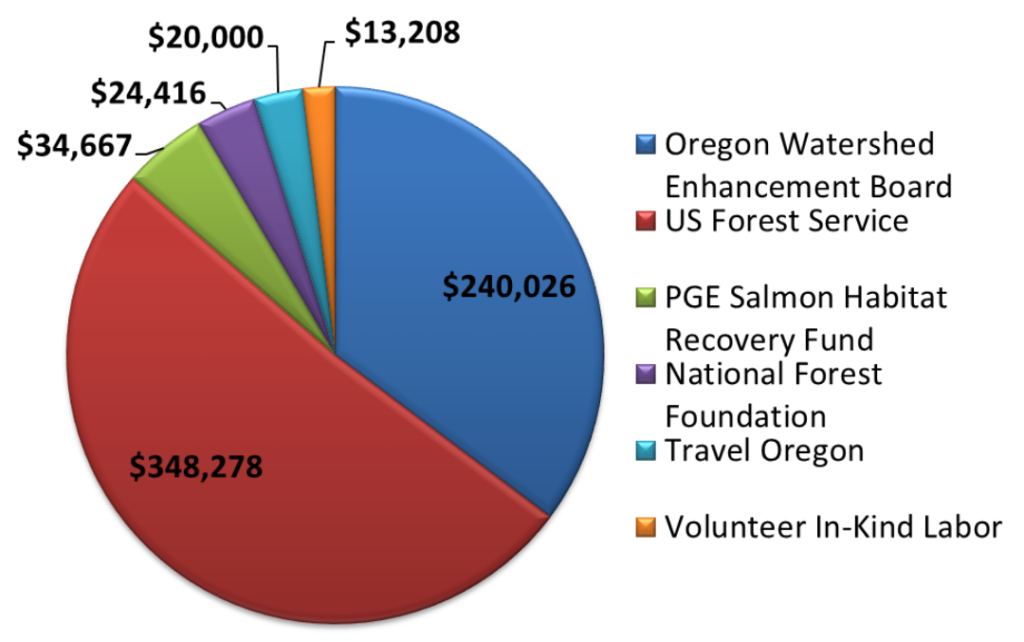coal creek floodplain restoration

Location
Upper Middle Fork Willamette, approximately 24 miles south of Oakridge, OR
Target Habitat
Floodplain
Timeline
Floodplain construction complete (June 20 – July 3, 2019)
Trail construction complete summer 2020
Project Size
25 acres – 0.3 stream miles
Partners
US Forest Service Middle Fork Ranger District, Oregon Dept. of Fish & Wildlife
funding

summary
In summer 2019 we worked with the US Forest Service (USFS) Middle Fork Ranger District and Haley Construction to restore 25 acres of floodplain habitat on Coal Creek in the Upper Middle Fork Willamette Watershed. This 0.3-mile section of Coal Creek is just above the confluence with the Middle Fork Willamette River, a location where the stream should be fanning out across the floodplain and creating diverse habitat for fish and wildlife. However, due to human-caused changes over the past several decades, Coal Creek was confined to its channel and, therefore, flowing fast like a fire hose which altered the natural stream processes and reduced the quality and diversity of the habitat.
To reconnect Coal Creek to its floodplain and restore processes, elevations across the project area needed to be smoothed out so that water could flow in any direction. Based on plans from the project team
made up of staff from the Forest Service and the Watershed Council, Haley Construction cleared eight acres of vegetation so that they could redistribute approximately 8,000 cubic yards of material. Haley then buried and scattered approximately 800 trees, many with rootwads attached, across the floodplain to keep the stream from cutting down into a new channel and to help spread flow. Haley Construction worked extremely fast, finishing the project a week early and under budget!
We are excited that this floodplain habitat is once again dynamic and will provide a plethora of native species with refugia from fast moving water; vegetation, macroinvertebrates, and nutrients to forage; and gravels in which to spawn and rear young. As the floodplain has settled into this new process we are continuing to partner with the US Forest Service to do regular monitoring at both Coal and Staley Creeks. As information becomes available from this monitoring we will share it with you on our Monitoring Page.
Middle fork trail - Integrating restoration with recreation
The Middle Fork Trail, a National Recreation Trail, begins at Timpanogas Lake and follows the Middle Fork Willamette River to Hills Creek Reservoir. During that 30+ mile journey, the trail passes through diverse ecosystems while also providing a diversity of trail experiences for non-motorized recreationists as they explore the headwaters of the Willamette River. As part of floodplain restoration together with the USFS, we worked with our contractor Dirt Mechanics to move the trail out of the floodplain, add more than two miles to its distance, and remove the necessity to connect trail segments on the road.
Local volunteer groups and students (Disciples of Dirt, Greater Oakridge Area Trail Stewards, Alpine Trail Crew Association, Trans-Cascadia, Twin Rivers Charter School) completed a 0.75-mile section of the trail, and Dirt Mechanics is completed the rest of the trail in the summer of 2020.
Trail construction was possible thanks to funding from the National Forest Foundation Matching Awards Program*, Travel Oregon Matching Grant, and the USFS.
*The National Forest Foundation promotes the enhancement and public enjoyment of the 193-million-acre National Forest System. By directly engaging Americans and leveraging private and public funding, the NFF improves forest health and Americans’ outdoor experiences. The NFF’s programs inform millions of Americans about the importance of these treasured landscapes. Each year, the NFF restores fish and wildlife habitat, plants trees in areas affected by fires, insects and disease, improves recreational opportunities, and enables communities to steward their National Forests and Grasslands.
video
Watch as large equipment works to even out the elevations so that water can spread across the floodplain.
Learn about why we do this type of restoration.
